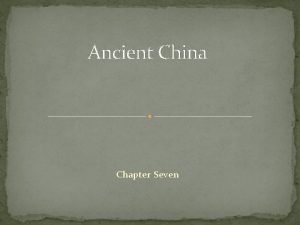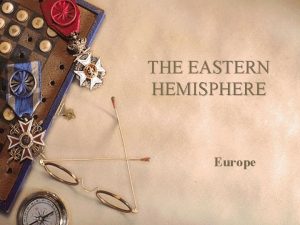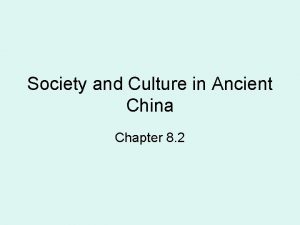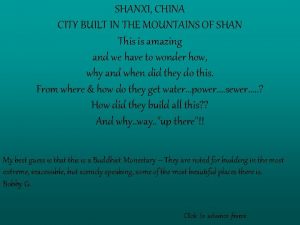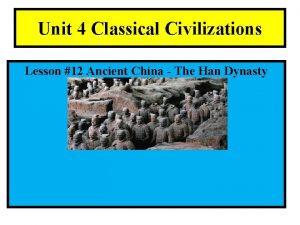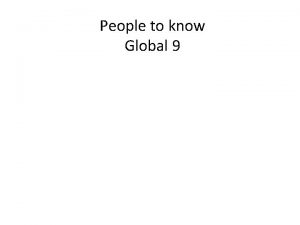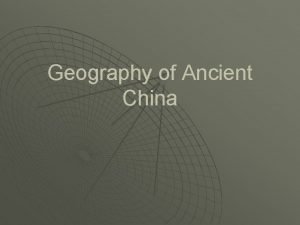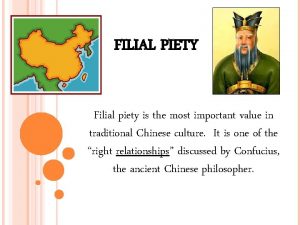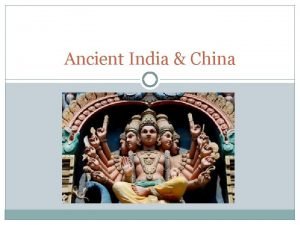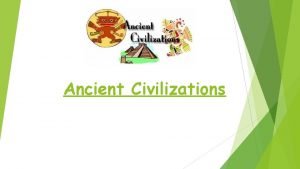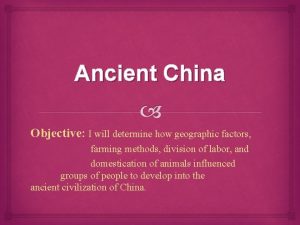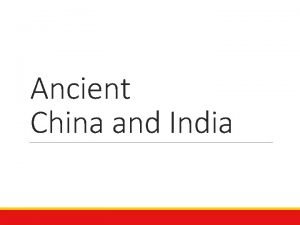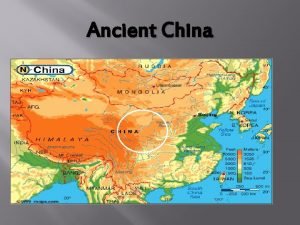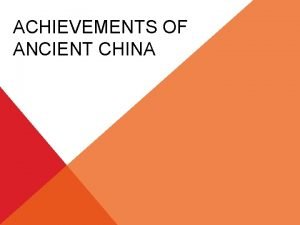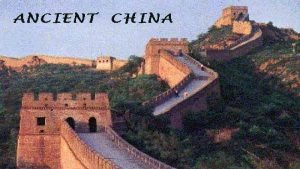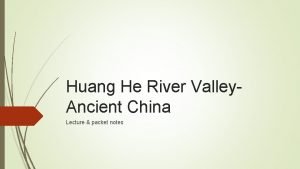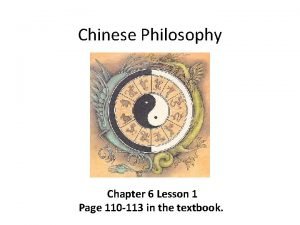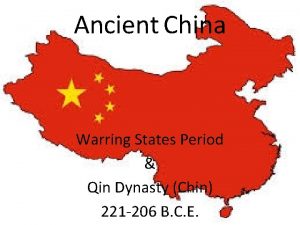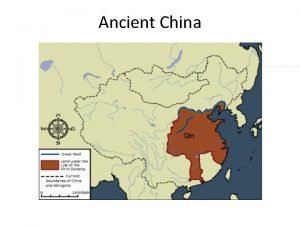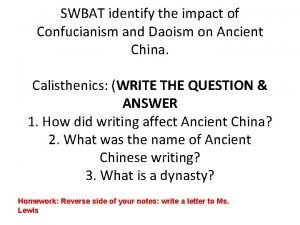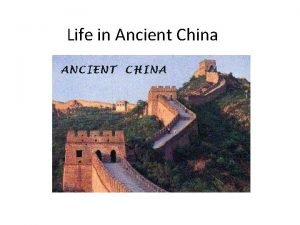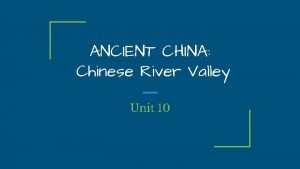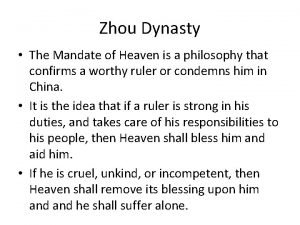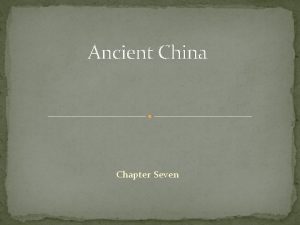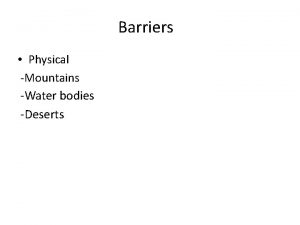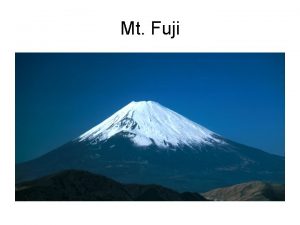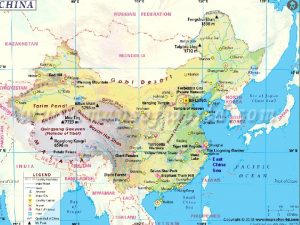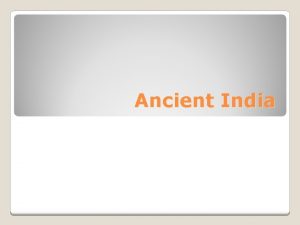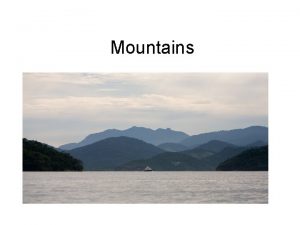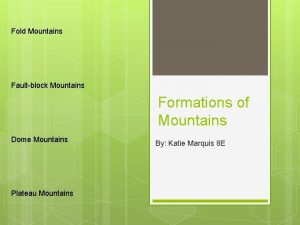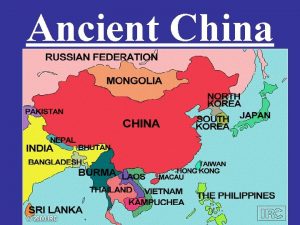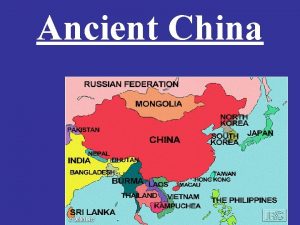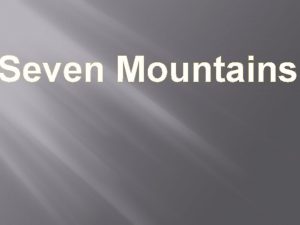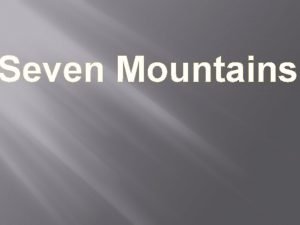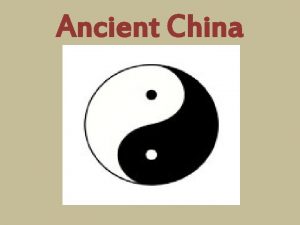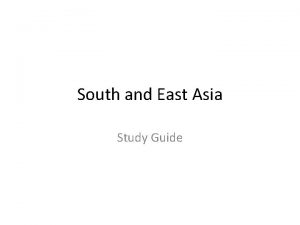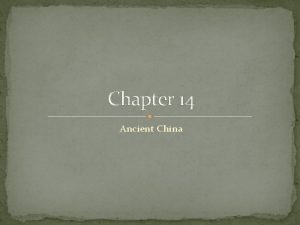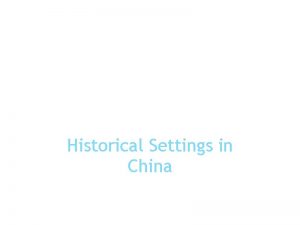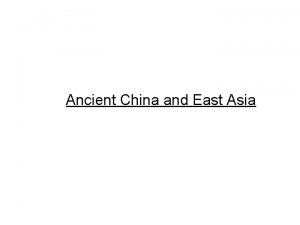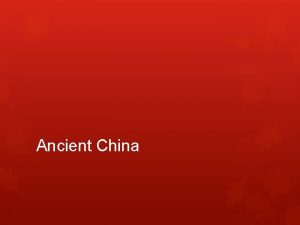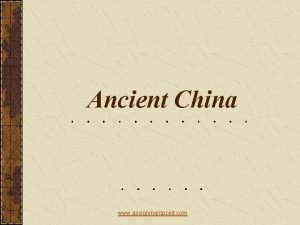Ancient China Chapter Seven Within the Himalayan Mountains


































- Slides: 34

Ancient China Chapter Seven

Within the Himalayan Mountains is the “The Roof of the World” the huge plateau, or raised plain that forms most of Tibet. This plateau sits higher than most of the mountains in the United States.

The two rivers that begin in the Tibetan Plateau are the Huang River and the Indus River, which begins a 3, 000 mile trip across northern China. The Huang has been a major force in China’s history. It picks up silt along its winding journey. The Huang River is also known as the Yellow River, and the Huang River empties into the Yellow Sea.

It spreads silt along the North China Plain to create one of the world’s largest deltas. The Huang River also creates miles of fertile marshland. The North China Plain is a large lowland region of eastern China watered by the Huang River. About 4, 000 B. C. , farming communities developed along the lower part of the Huang River. China’s oldest civilization grew from these farming communities.

Define Loess-What color is it? Loess has been a blessing and a curse to Chinese farmers. Explain this: while it provides fertile soil, its lightness makes it easy for storms to carry that kind of soil away.

Like farmers in the Indus Valley, ancient Chinese farmers made use of the Huang Valley’s fertile soil. They also fought to control river flooding.

Compare Rivers!! Use the following data to complete the following: 1, 800 3, 000, and 4, 000 The Nile is about_____ miles long, the Indus is about _____miles long and the Huang River is about _____miles long. How much longer is the Nile than the Indus? How much longer is the Nile than the Huang.

Huang farmers needed to control floods. They began building earth levees to hold back the Huang River. Define Levee Over time, what happened because of the build up of loess?

The ancient Chinese farmers (like the Sumerians and people under Chandgrupta in India) built canals to bring water to their fields. What happened to these canals? Loess provided a rich soil. What did the farmers grow in this region? When farmers cleared trees from rich loess-lands to plant crops, what happened? And what is it?

Is all of China suitable for farming? Why? Define steppes Like people in other river valleys, farmers along the Huang raised crops. Along China’s northern steppes, people herded animals. Map: Using the maps on page 161, 169, 172, 403 -404, R-10 and 406, draw and label a map of China with the following locations: China, Pacific Ocean, Tibetan Plateau, Huang River, Great Wall of China, Chang River (aka Yangtze River), Beijing (aka Peking), Qin Mts. (Qinling Mts), East China Sea, Silk Road, South China Sea, Gobi Desert This map should be completed on computer paper.

The First Dynasty Lesson 2 Shang Dynasty 商朝

At the same time that Egypt was being united and city-states and towns were expanding in the Fertile Crescent and Indus Valley, farms along China’s Huang river were growing larger. By about 1700 B. C. one kingdom had won control over the large Huang River delta One of its earliest capitals was a city called Shang, which became the state’s name. Since it was ruled by one family for a long period of time, the government became known as the Shang dynasty

The Emperor’s Clay Army Qin Dynasty Lesson 3

The Shang dynasty came to an end around 1100 B. C. . For many years afterward there was conflict and turmoil in the Huang River Valley. Slowly one region, called Qin (pronounced CHIN) built up its strength. Qin’s ruler was a general who would one day order the making of the great clay army.

In 211 B. C. this general led a real army to take control of the Huang River delta. He eventually conquered all of northern China. The Qin general declared himself China’s emperor. What is an emperor? This emperor took the name, Shihuangdi, which means “First Grand Emperor” Shihuangdi boasted that his Qin dynasty would last for 10, 000 generations.

What played a part in the victory of the Qin armies? The original Qin region was protected by the Qinling Mountains on one side and by the Huang River on the other. Shihuandgdi had new ideas about how a government should be run. He split the empire into 36 provinces. Define province

What did this emperor let farmers do? Shihuangdi forced many nobles to move the capital city of Xianyang. What did he take away? Why do you think he did this?

Local leaders used the writing systems to report to the capital. Written language also helped the government to record and collect taxes. Shihuangdi also created a single system of money to be used throughout the empire. Why would this be helpful to the empire? Coins were made out of bronze and had a hole in the center which allowed people to keep their money on a string.

Shihuangdi believed in a philosophy called legalism. It emphasized strong government, strict laws, and efficient enforcement of them. Legalistic administrative practices have been a continuing force in Chinese governance. Today, the term “legalist” is sometimes used to refer to someone who is overly strict in adhering to the letter of the law.

Create a Flow Map showing the events from the end of the Shang Dynasty to the founding of Qin empire. (Events below are not in order-use you text to create this Flow Map): Conflict and Turmoil, Chinese empire, Qin control of Northern China, fall of the Shang dynasty, build up of Qin strength.

Under Shihuangdi’s leadership, unified China grew bigger and stronger. The empire also became increasingly rich by the taxes from China’s farmers. Farmers were required to build the highways that linked the cities of the empire. Farmers were required to strengthen and connect walls along the empire’s northern border. These walls were built to keep out the people of the northern steppes.

Later walls made up the Great Wall of China that eventually grew to be more than 1, 500 miles long! Why were farmers considered to be the backbone of the Qin Empire? What special jobs did they do?

Farmers also spent most of their time growing crops such as wheat, rice, and other crops. One of the greatest building projects in the Qin Empire was the construction of a tomb for Shihuangdi. The emperor wanted his tomb to be a spectacular mirror of the real world. Describe the clay army

How long did the Qin dynasty actually last? What did the farmers and nobles do after Shihuangdi’s death? China’s first emperor would leave a lasting legacy, which included a centralized system of writing, government, and money.

Main Ideas Around 221 B. C. , Shihuangdi unified China with its powerful armies and by strengthening government. He created standard (same) writing and money systems across the empire. Farmers were the backbone fo the Qin Economy. They served as farmers and builders. Read paragraphs on p. 172 -173 about the great wall of China built under the rule of Shihuangdi.

Confucius Changes China Han Dynasty Lesson 4

In 206 B. C. , Shihuangdi’s Qin dynasty was overthrown by rebel armies. These armies were led by a farmer-turned-general called Han Gaozu. His family began the mighty Han dynasty, which would rule China for over 400 years. During the Han dynasty, China expanded north to what are today North and South Korea and south to the country of Vietnam. Find these on page R 10 and draw an illustration of these countries and label them.

Shihuangdi lived by the idea that a ruler should be able to do whatever he chooses. Later, Han rulers thoughts were based on the teachings of a man named Confucius.

Like Buddha, Confucius lived through an age of warfare and conflict. In this time of conflict, Confucius suggested a different, more peaceful way of living. Unlike Buddha, Confucius’ ideas would not start a new religion, but they would reshape entire civilizations. Confucius had a passion for learning. His mastery of subjects helped him get a job in government. In later years, he devoted his life to teaching.

Confucius’ ideas are called Confucianism. What did Confucius think about society? A central idea of Confucianism was to have respect within the family. This idea also applied to government. A child must respect a parent and a subject must respect the ruler. However, the ruler had to be wise and good. Confucianism taught that emperors did not have the right to rule just because they came from a certain family.

Each emperor, according to Confucius, received a right to rule from the gods, called the Mandate of Heaven. This mandate, or command echoed the Shang belief that the gods spoke to the kings through oracle bones. Read the Golden Rule of Confucius under Many Voices. Wudi was the first strong emperor of the Han dynasty. Wudi created schools to prepare students for government service.

Very good students sometimes were sent to the empire’s best school, the Grand School. During the Han Dynasty many inventions were made. Han craft workers invented paper which provided a way to keep written records. They mad paper from the bark of mulberry trees. The mulberry trees are the ones that feed China’s silkworms.

Create a classification system for the Han Dynasty: Han Dynasty Achievements Science Math Arts Trade

Silk Making- page 180 Silk is made from silkworms. Ancient Chinese farmers discovered how to make silk around 2700 B. C. . In the spring women cut the leaves from the mulberry trees to feed the silkworms. The silkworms spin cocoons. Why did Chinese emperors decide to keep silk making a secret from other civilizations? What would rulers threaten people with if they told the secret of making silk? Silk production is still limited mainly to China remains the largest producer of silk. Japan is second, countries of the former Soviet Union are third. The only significant producer of silk in the Americas is Brazil.
 Himalayan mountains ancient china
Himalayan mountains ancient china Ancient india vs ancient china
Ancient india vs ancient china Europe in which hemisphere
Europe in which hemisphere Jesus seminary
Jesus seminary Importance of aromatic plants
Importance of aromatic plants Phenotypic trait
Phenotypic trait Why himalayan rivers are pernnial in nature
Why himalayan rivers are pernnial in nature Himalayan bank merger
Himalayan bank merger Chapter 8 ancient china
Chapter 8 ancient china Shanxi china city built in the mountains of shan
Shanxi china city built in the mountains of shan Hills in jerusalem
Hills in jerusalem Seven heavenly virtues mal
Seven heavenly virtues mal Ancient china zhou dynasty
Ancient china zhou dynasty Ancient china social pyramid
Ancient china social pyramid Marco polo accomplishments
Marco polo accomplishments Ancient china deserts
Ancient china deserts Why is filial piety important
Why is filial piety important Ancient china map
Ancient china map Ancient china confucius
Ancient china confucius Huang he
Huang he Ancient china social class
Ancient china social class Physical map of ancient china
Physical map of ancient china Achievements of china
Achievements of china Why did the shang rulers become powerful
Why did the shang rulers become powerful Hwang ho river valley
Hwang ho river valley Lesson 1 schools of thought in ancient china
Lesson 1 schools of thought in ancient china Ancient china people
Ancient china people Zhou dynasty wars
Zhou dynasty wars What was the impact of daoism in ancient china
What was the impact of daoism in ancient china Concept of physical education during primitive period
Concept of physical education during primitive period Terrace farming in ancient china
Terrace farming in ancient china What is believed to be the 1 stdynasty of ancient china?
What is believed to be the 1 stdynasty of ancient china? Mandate of heaven zhou
Mandate of heaven zhou Engineering an empire china worksheet
Engineering an empire china worksheet How long ago was ancient china
How long ago was ancient china
